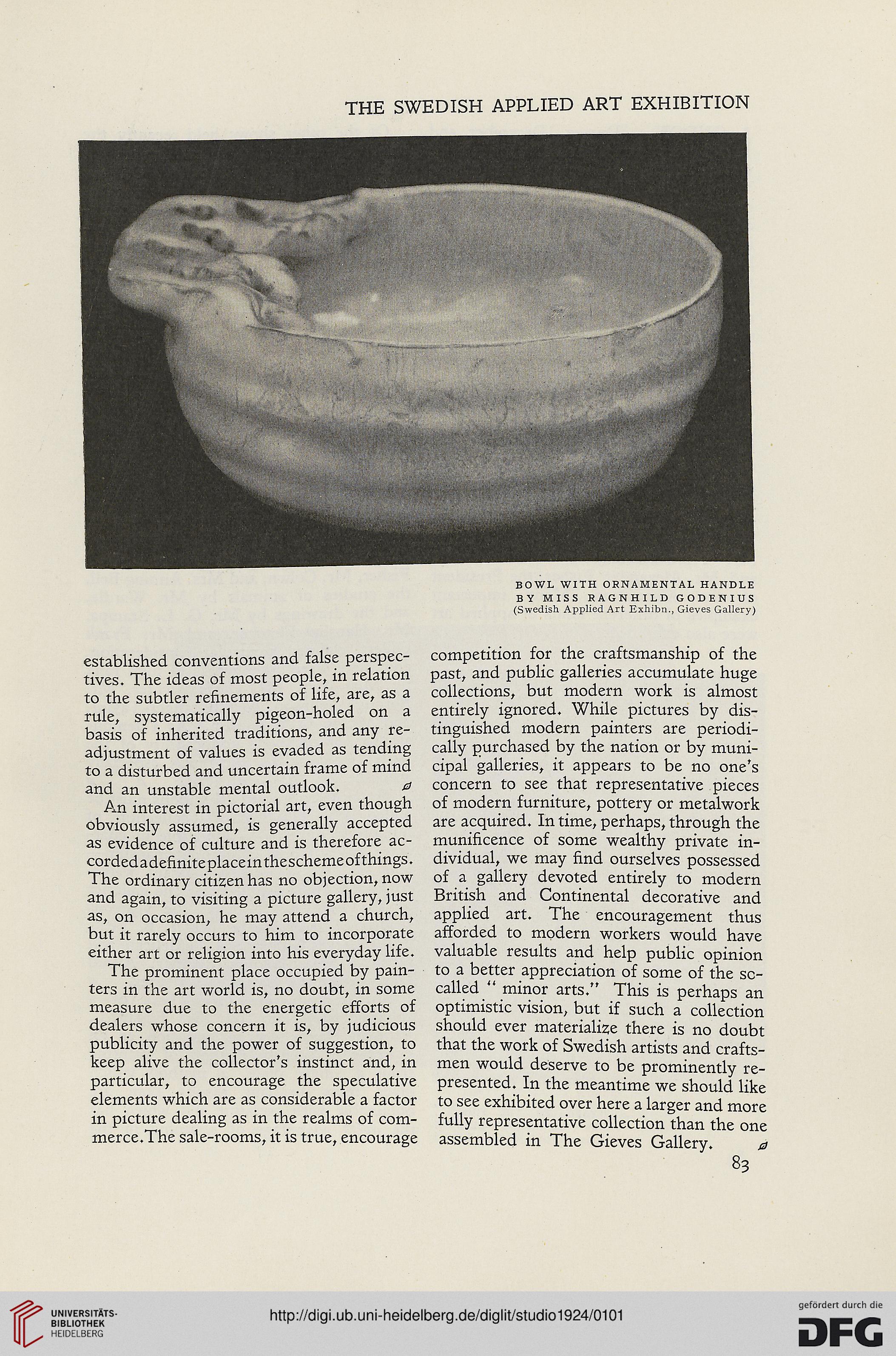THE SWEDISH APPLIED ART EXHIBITION
BOWL WITH ORNAMENTAL HANDLE
BY MISS RAGNHILD GODENIUS
(Swedish Applied Art Exhibn., Gieves Gallery)
established conventions and false perspec-
tives. The ideas of most people, in relation
to the subtler refinements of life, are, as a
rule, systematically pigeon-holed on a
basis of inherited traditions, and any re-
adjustment of values is evaded as tending
to a disturbed and uncertain frame of mind
and an unstable mental outlook. o
An interest in pictorial art, even though
obviously assumed, is generally accepted
as evidence of culture and is therefore ac-
cordedadefiniteplaceintheschemeofthings.
The ordinary citizen has no objection, now
and again, to visiting a picture gallery, just
as, on occasion, he may attend a church,
but it rarely occurs to him to incorporate
either art or religion into his everyday life.
The prominent place occupied by pain-
ters in the art world is, no doubt, in some
measure due to the energetic efforts of
dealers whose concern it is, by judicious
publicity and the power of suggestion, to
keep alive the collector’s instinct and, in
particular, to encourage the speculative
elements which are as considerable a factor
in picture dealing as in the realms of com-
merce.The sale-rooms, it is true, encourage
competition for the craftsmanship of the
past, and public galleries accumulate huge
collections, but modern work is almost
entirely ignored. While pictures by dis-
tinguished modern painters are periodi-
cally purchased by the nation or by muni-
cipal galleries, it appears to be no one’s
concern to see that representative pieces
of modern furniture, pottery or metalwork
are acquired. In time, perhaps, through the
munificence of some wealthy private in-
dividual, we may find ourselves possessed
of a gallery devoted entirely to modern
British and Continental decorative and
applied art. The encouragement thus
afforded to modern workers would have
valuable results and help public opinion
to a better appreciation of some of the sc-
called “ minor arts.” This is perhaps an
optimistic vision, but if such a collection
should ever materialize there is no doubt
that the work of Swedish artists and crafts-
men would deserve to be prominently re-
presented. In the meantime we should like
to see exhibited over here a larger and more
fully representative collection than the one
assembled in The Gieves Gallery. a
83
BOWL WITH ORNAMENTAL HANDLE
BY MISS RAGNHILD GODENIUS
(Swedish Applied Art Exhibn., Gieves Gallery)
established conventions and false perspec-
tives. The ideas of most people, in relation
to the subtler refinements of life, are, as a
rule, systematically pigeon-holed on a
basis of inherited traditions, and any re-
adjustment of values is evaded as tending
to a disturbed and uncertain frame of mind
and an unstable mental outlook. o
An interest in pictorial art, even though
obviously assumed, is generally accepted
as evidence of culture and is therefore ac-
cordedadefiniteplaceintheschemeofthings.
The ordinary citizen has no objection, now
and again, to visiting a picture gallery, just
as, on occasion, he may attend a church,
but it rarely occurs to him to incorporate
either art or religion into his everyday life.
The prominent place occupied by pain-
ters in the art world is, no doubt, in some
measure due to the energetic efforts of
dealers whose concern it is, by judicious
publicity and the power of suggestion, to
keep alive the collector’s instinct and, in
particular, to encourage the speculative
elements which are as considerable a factor
in picture dealing as in the realms of com-
merce.The sale-rooms, it is true, encourage
competition for the craftsmanship of the
past, and public galleries accumulate huge
collections, but modern work is almost
entirely ignored. While pictures by dis-
tinguished modern painters are periodi-
cally purchased by the nation or by muni-
cipal galleries, it appears to be no one’s
concern to see that representative pieces
of modern furniture, pottery or metalwork
are acquired. In time, perhaps, through the
munificence of some wealthy private in-
dividual, we may find ourselves possessed
of a gallery devoted entirely to modern
British and Continental decorative and
applied art. The encouragement thus
afforded to modern workers would have
valuable results and help public opinion
to a better appreciation of some of the sc-
called “ minor arts.” This is perhaps an
optimistic vision, but if such a collection
should ever materialize there is no doubt
that the work of Swedish artists and crafts-
men would deserve to be prominently re-
presented. In the meantime we should like
to see exhibited over here a larger and more
fully representative collection than the one
assembled in The Gieves Gallery. a
83




